Coupling Coordination Analysis of Ecosystem Services and Urbanization in Inner Mongolia, China
Abstract
1. Introduction
2. Study Area, Data Sources, and Research Methods
2.1. Study Area
2.2. Data Sources
2.3. Study Methods
2.3.1. Assessing Ecosystem Service Values
2.3.2. Comprehensive Urbanization Indicators Assessment
2.3.3. Coupling Coordination Relationship between ESs and Urbanization
3. Results
3.1. Spatiotemporal Change of the ESV
3.2. The Dynamics of Urbanization in Inner Mongolia
3.3. CCD between Urbanization and Ecosystem Services
3.3.1. Coupling Degree of ESs and Urbanization
3.3.2. Coupling Coordination Analysis of Urbanization and Ecosystem Services
4. Discussion
4.1. Coupling Coordination Analysis between ESs and Urbanization
4.2. Policy Implications
4.3. Limitations and Suggestions
5. Conclusions
Author Contributions
Funding
Data Availability Statement
Conflicts of Interest
References
- NBSC. Statistical Communique of the People’s Republic Of China on the 2020 National Economic and Social Development; China Statistics Press: Beijing, China, 2020. [Google Scholar]
- Liu, N.; Liu, C.; Xia, Y.; Da, B. Examining the coordination between urbanization and eco-environment using coupling and spatial analyses: A case study in China. Ecol. Indic. 2018, 93, 1163–1175. [Google Scholar] [CrossRef]
- Liu, W.; Jiao, F.; Ren, L.; Xu, X.; Wang, J.; Wang, X. Coupling coordination relationship between urbanization and atmospheric environment security in Jinan City. J. Clean. Prod. 2018, 204, 1–11. [Google Scholar] [CrossRef]
- Shi, Y.; Feng, C.C.; Yu, Q.R.; Guo, L. Integrating supply and demand factors for estimating ecosystem services scarcity value and its response to urbanization in typical mountainous and hilly regions of south China. Sci. Total Environ. 2021, 796, 149032. [Google Scholar] [CrossRef]
- Qiu, B.; Li, H.; Zhou, M.; Zhang, L. Vulnerability of ecosystem services provisioning to urbanization: A case of China. Ecol. Indic. 2015, 57, 505–513. [Google Scholar] [CrossRef]
- Huang, Q.; Peng, B.; Elahi, E.; Wan, A. Evolution and driving mechanism of ecological security pattern: A case study of Yangtze River urban agglomeration. Integr. Environ. Assess. Manag. 2021, 17, 573–583. [Google Scholar] [CrossRef] [PubMed]
- Wang, L.; Li, Q.; Bi, H.; Mao, X.Z. Human impacts and changes in the coastal waters of south China. Sci. Total Environ. 2016, 562, 108–114. [Google Scholar] [CrossRef]
- Guerry, A.D.; Polasky, S.; Lubchenco, J.; Chaplin-Kramer, R.; Daily, G.C.; Griffin, R.; Ruckelshaus, M.; Bateman, I.J.; Duraiappah, A.; Elmqvist, T.; et al. Natural capital and ecosystem services informing decisions: From promise to practice. Proc. Natl. Acad. Sci. USA 2015, 112, 7348–7355. [Google Scholar] [CrossRef] [PubMed]
- Arowolo, A.O.; Deng, X.; Olatunji, O.A.; Obayelu, A.E. Assessing changes in the value of ecosystem services in response to land-use/land-cover dynamics in Nigeria. Sci. Total Environ. 2018, 636, 597–609. [Google Scholar] [CrossRef]
- Yuan, M.H.; Lo, S.L. Ecosystem services and sustainable development: Perspectives f1 rom the food-energy-water Nexus. Ecosyst. Serv. 2020, 46, 101217. [Google Scholar] [CrossRef]
- Chen, W.; Chi, G.; Li, J. The spatial association of ecosystem services with land use and land cover change at the county level in China, 1995–2015. Sci. Total Environ. 2019, 669, 459–470. [Google Scholar] [CrossRef]
- Long, H.; Liu, Y.; Hou, X.; Li, T.; Li, Y. Effects of land use transitions due to rapid urbanization on ecosystem services: Implications for urban planning in the new developing area of China. Habitat Int. 2014, 44, 536–544. [Google Scholar] [CrossRef]
- Ai, J.; Feng, L.; Dong, X.; Zhu, X.; Li, Y. Exploring coupling coordination between urbanization and ecosystem quality (1985–2010): A case study from Lianyungang City, China. Front. Earth Sci. 2016, 10, 527–545. [Google Scholar] [CrossRef]
- Al-Mulali, U.; Solarin, S.A.; Ozturk, I. Investigating the presence of the environmental Kuznets curve (EKC) hypothesis in Kenya: An autoregressive distributed lag (ARDL) approach. Nat. Hazards 2016, 80, 1729–1747. [Google Scholar] [CrossRef]
- Li, C.; Li, J.; Wu, J. Quantifying the speed, growth modes, and landscape pattern changes of urbanization: A hierarchical patch dynamics approach. Landsc. Ecol. 2013, 28, 1875–1888. [Google Scholar] [CrossRef]
- Li, B.; Chen, D.; Wu, S.; Zhou, S.; Wang, T.; Chen, H. Spatio-temporal assessment of urbanization impacts on ecosystem services: Case study of Nanjing City, China. Ecol. Indic. 2016, 71, 416–427. [Google Scholar] [CrossRef]
- Costanza, R.; D’Arge, R.; De Groot, R.; Farber, S.; Grasso, M.; Hannon, B.; Limburg, K.; Naeem, S.; O’Neill, R.V.; Paruelo, J.; et al. The value of the world’s ecosystem services and natural capital. Nature 1997, 387, 253–260. [Google Scholar] [CrossRef]
- Zamboni, N.S.; Noleto Filho, E.M.; Carvalho, A.R. Unfolding differences in the distribution of coastal marine ecosystem services values among developed and developing countries. Ecol. Econ. 2021, 189, 107151. [Google Scholar] [CrossRef]
- Rahman, M.M.; Szabó, G. Impact of land use and land cover changes on urban ecosystem service value in Dhaka, Bangladesh. Land 2021, 10, 793. [Google Scholar] [CrossRef]
- Hou, X.; Liu, J.; Zhang, D.; Zhao, M.; Xia, C. Impact of urbanization on the eco-efficiency of cultivated land utilization: A case study on the Yangtze River Economic Belt, China. J. Clean. Prod. 2019, 238, 117916. [Google Scholar] [CrossRef]
- Zhang, W.; Yang, D.; Huo, J. Studies of the relationship between city size and urban benefits in China based on a panel data model. Sustainability 2016, 8, 554. [Google Scholar] [CrossRef]
- Wang, J.; Zhou, W.; Pickett, S.T.A.; Yu, W.; Li, W. A multiscale analysis of urbanization effects on ecosystem services supply in an urban megaregion. Sci. Total Environ. 2019, 662, 824–833. [Google Scholar] [CrossRef] [PubMed]
- Peng, J.; Tian, L.; Liu, Y.; Zhao, M.; Hu, Y.N.; Wu, J. Ecosystem services response to urbanization in metropolitan areas: Thresholds identification. Sci. Total Environ. 2017, 607–608, 706–714. [Google Scholar] [CrossRef] [PubMed]
- Cortinovis, C.; Geneletti, D. Ecosystem services in urban plans: What is there, and what is still needed for better decisions. Land Use Policy 2018, 70, 298–312. [Google Scholar] [CrossRef]
- Ding, T.; Chen, J.; Fang, Z.; Chen, J. Assessment of coordinative relationship between comprehensive ecosystem service and urbanization: A case study of Yangtze River Delta urban Agglomerations, China. Ecol. Indic. 2021, 133, 108454. [Google Scholar] [CrossRef]
- Xiao, R.; Lin, M.; Fei, X.; Li, Y.; Zhang, Z.; Meng, Q. Exploring the interactive coercing relationship between urbanization and ecosystem service value in the Shanghai–Hangzhou Bay Metropolitan Region. J. Clean. Prod. 2020, 253, 119803. [Google Scholar] [CrossRef]
- Sun, Y.; Liu, S.; Dong, Y.; An, Y.; Shi, F.; Dong, S.; Liu, G. Spatio-temporal evolution scenarios and the coupling analysis of ecosystem services with land use change in China. Sci. Total Environ. 2019, 681, 211–225. [Google Scholar] [CrossRef]
- Yu, Y.; Tong, Y.; Tang, W.; Yuan, Y.; Chen, Y. Identifying spatiotemporal interactions between urbanization and eco-environment in the Urban agglomeration in the middle reaches of the Yangtze River, China. Sustainability 2018, 10, 290. [Google Scholar] [CrossRef]
- Sannigrahi, S.; Zhang, Q.; Pilla, F.; Joshi, P.K.; Basu, B.; Keesstra, S.; Roy, P.S.; Wang, Y.; Sutton, P.C.; Chakraborti, S.; et al. Responses of ecosystem services to natural and anthropogenic forcings: A spatial regression based assessment in the world’s largest mangrove ecosystem. Sci. Total Environ. 2020, 715, 137004. [Google Scholar] [CrossRef]
- Yao, X.; Kou, D.; Shao, S.; Li, X.; Wang, W.; Zhang, C. Can urbanization process and carbon emission abatement be harmonious? New evidence from China. Environ. Impact Assess. Rev. 2018, 71, 70–83. [Google Scholar] [CrossRef]
- Zheng, J.; Hu, Y.; Boldanov, T.; Bazarzhapov, T.; Meng, D.; Li, Y.; Dong, S. Comprehensive assessment of the coupling coordination degree between urbanization and ecological environment in the Siberian and Far East Federal Districts, Russia from 2005 to 2017. PeerJ 2020, 8, e9125. [Google Scholar] [CrossRef]
- Liu, S.; Bai, J.; Chen, J. Measuring SDG 15 at the county scale: Localization and practice of SDGs indicators based on geospatial information. ISPRS Int. J. Geo-Inf. 2019, 8, 515. [Google Scholar] [CrossRef]
- Inner Mongolia Autonomous Region Bureau of Statistics. Inner Mongolia Statistical Yearbooks 2020; China Statistic Press: Beijing, China, 2020. [Google Scholar]
- Xu, G.H.; Wu, J.G. Social-ecological transformations of Inner Mongolia: A sustainability perspective. Ecol. Process. 2016, 5, 23. [Google Scholar] [CrossRef]
- Zhang, H.; Fan, J.; Cao, W.; Harris, W.; Li, Y.; Chi, W.; Wang, S. Response of wind erosion dynamics to climate change and human activity in Inner Mongolia, China during 1990 to 2015. Sci. Total Environ. 2018, 639, 1038–1050. [Google Scholar] [CrossRef] [PubMed]
- Zhou, Y.; Ning, L.; Bai, X. Spatial and temporal changes of human disturbances and their effects on landscape patterns in the Jiangsu coastal zone, China. Ecol. Indic. 2018, 93, 111–122. [Google Scholar] [CrossRef]
- de Groot, R.S.; Alkemade, R.; Braat, L.; Hein, L.; Willemen, L. Challenges in integrating the concept of ecosystem services and values in landscape planning, management and decision making. Ecol. Complex. 2010, 7, 260–272. [Google Scholar] [CrossRef]
- Millennium Ecosystem Assessment. Living Beyond Our Means: Natural Assets and Human Well-Being: Statement from the Board; Millennium Ecosystem Assessment: Washington, DC, USA, 2005. [Google Scholar]
- Xie, G.D.; Zhang, C.X.; Zhang, L.M.; Chen, W.H.; Li, S.M. Improvement of the evaluation method for ecosystem ser-vice value based on per unit area. J. Nat. Resour. 2015, 30, 1243–1254. [Google Scholar]
- Xie, G.D.; Lu, C.X.; Leng, Y.F.; Zheng, D.; Li, S.C. Ecological assets valuation of the Tibetan Plateau. J. Nat. Resour. 2003, 18, 189–196. [Google Scholar]
- Zhang, Y.; Liu, Y.; Zhang, Y.; Liu, Y.; Zhang, G.; Chen, Y. On the spatial relationship between ecosystem services and urbanization: A case study in Wuhan. China. Sci. Total Environ. 2018, 637–638, 780–790. [Google Scholar] [CrossRef]
- Morzillo, A.T.; de Beurs, K.M.; Martin-Mikle, C.J. A conceptual framework to evaluate human-wildlife interactions within coupled human and natural systems. Ecol. Soc. 2014, 19, 44. [Google Scholar] [CrossRef]
- Kurniawan, F.; Adrianto, L.; Bengen, D.G.; Prasetyo, L.B. The social-ecological status of small islands: An evaluation of island tourism destination management in Indonesia. Tour. Manag. Perspect. 2019, 31, 136–144. [Google Scholar] [CrossRef]
- Zhu, S.; Huang, J.; Zhao, Y. Coupling coordination analysis of ecosystem services and urban development of resource-based cities: A case study of Tangshan city. Ecol. Indic. 2022, 136, 108706. [Google Scholar] [CrossRef]
- Dong, F.; Li, W. Research on the coupling coordination degree of “upstream-midstream-downstream” of China’s wind power industry chain. J. Clean. Prod. 2021, 283, 124633. [Google Scholar] [CrossRef]
- Zhang, Z.; Li, Y. Coupling coordination and spatiotemporal dynamic evolution between urbanization and geological hazards–A case study from China. Sci. Total Environ. 2020, 728, 138825. [Google Scholar] [CrossRef] [PubMed]
- Shi, T.; Yang, S.; Zhang, W.; Zhou, Q. Coupling coordination degree measurement and spatiotemporal heterogeneity between economic development and ecological environment—Empirical evidence from tropical and subtropical regions of China. J. Clean. Prod. 2020, 244, 118739. [Google Scholar] [CrossRef]
- Ariken, M.; Zhang, F.; Chan, N.W.; Kung, H.T. Coupling coordination analysis and spatio-temporal heterogeneity between urbanization and eco-environment along the Silk Road Economic Belt in China. Ecol. Indic. 2021, 121, 107014. [Google Scholar] [CrossRef]
- Zheng, H.; Miao, C.; Wu, J.; Lei, X.; Liao, W.; Li, H. Temporal and spatial variations in water discharge and sediment load on the Loess Plateau, China: A high-density study. Sci. Total Environ. 2019, 666, 875–886. [Google Scholar] [CrossRef]
- Salvati, L.; Zambon, I.; Chelli, F.M.; Serra, P. Do spatial patterns of urbanization and land consumption reflect different socioeconomic contexts in Europe? Sci. Total Environ. 2018, 625, 722–730. [Google Scholar] [CrossRef]
- Feng, X.; Fu, B.; Piao, S.; Wang, S.; Ciais, P.; Zeng, Z.; Lü, Y.; Zeng, Y.; Li, Y.; Jiang, X.; et al. Revegetation in China’s Loess Plateau is approaching sustainable water resource limits. Nat. Clim. Chang. 2016, 6, 1019–1022. [Google Scholar] [CrossRef]
- Grimm, N.B.; Faeth, S.H.; Golubiewski, N.E.; Redman, C.L.; Wu, J.; Bai, X.; Briggs, J.M. Global change and the ecology of cities. Science 2008, 319, 756–760. [Google Scholar] [CrossRef]
- Zhou, D.; Tian, Y.; Jiang, G. Spatio-temporal investigation of the interactive relationship between urbanization and ecosystem services: Case study of the Jingjinji urban agglomeration, China. Ecol. Indic. 2018, 95, 152–164. [Google Scholar] [CrossRef]
- Tian, Y.; Zhou, D.; Jiang, G. Conflict or coordination? Multiscale assessment of the spatio-temporal coupling relationship between urbanization and ecosystem services: The case of the Jingjinji Region, China. Ecol. Indic. 2020, 117, 106543. [Google Scholar] [CrossRef]
- Cao, Y.; Kong, L.; Zhang, L.; Ouyang, Z. The balance between economic development and ecosystem service value in the process of land urbanization: A case study of China’s land urbanization from 2000 to 2015. Land Use Policy 2021, 108, 105536. [Google Scholar] [CrossRef]
- Chuai, X.; Huang, X.; Wang, W.; Wu, C.; Zhao, R. Spatial simulation of land use based on terrestrial ecosystem carbon storage in Coastal Jiangsu, China. Sci. Rep. 2014, 4, 5667. [Google Scholar] [CrossRef]
- Xiong, Y.; Zhang, F.M.; Gong, C.A.; Luo, P. Spatial-temporal evolvement of ecosystem service value in Hunan Province based on LUCC. Resour. Environ. Yangtze Basin 2018, 27, 1397–1408. [Google Scholar]
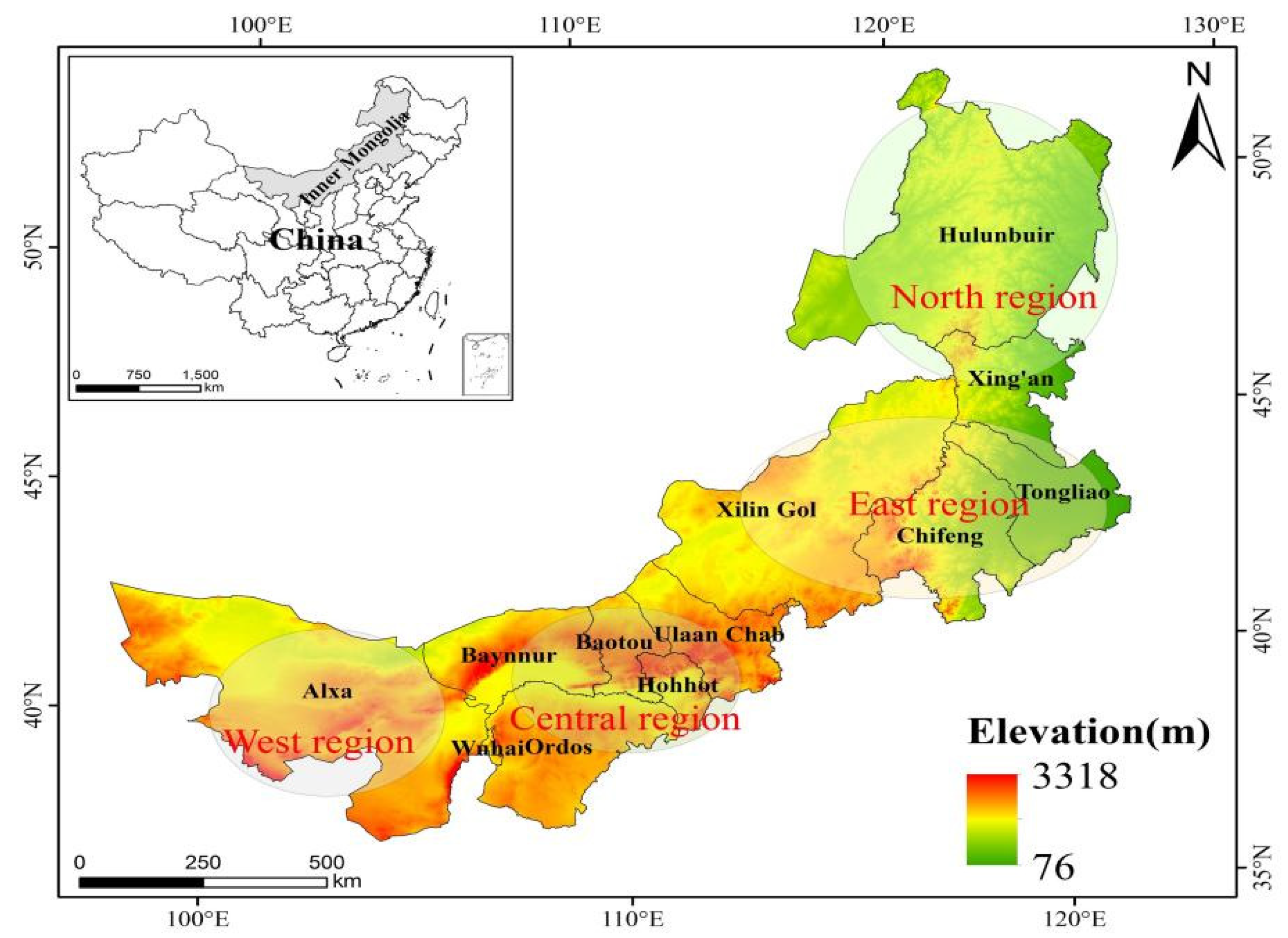
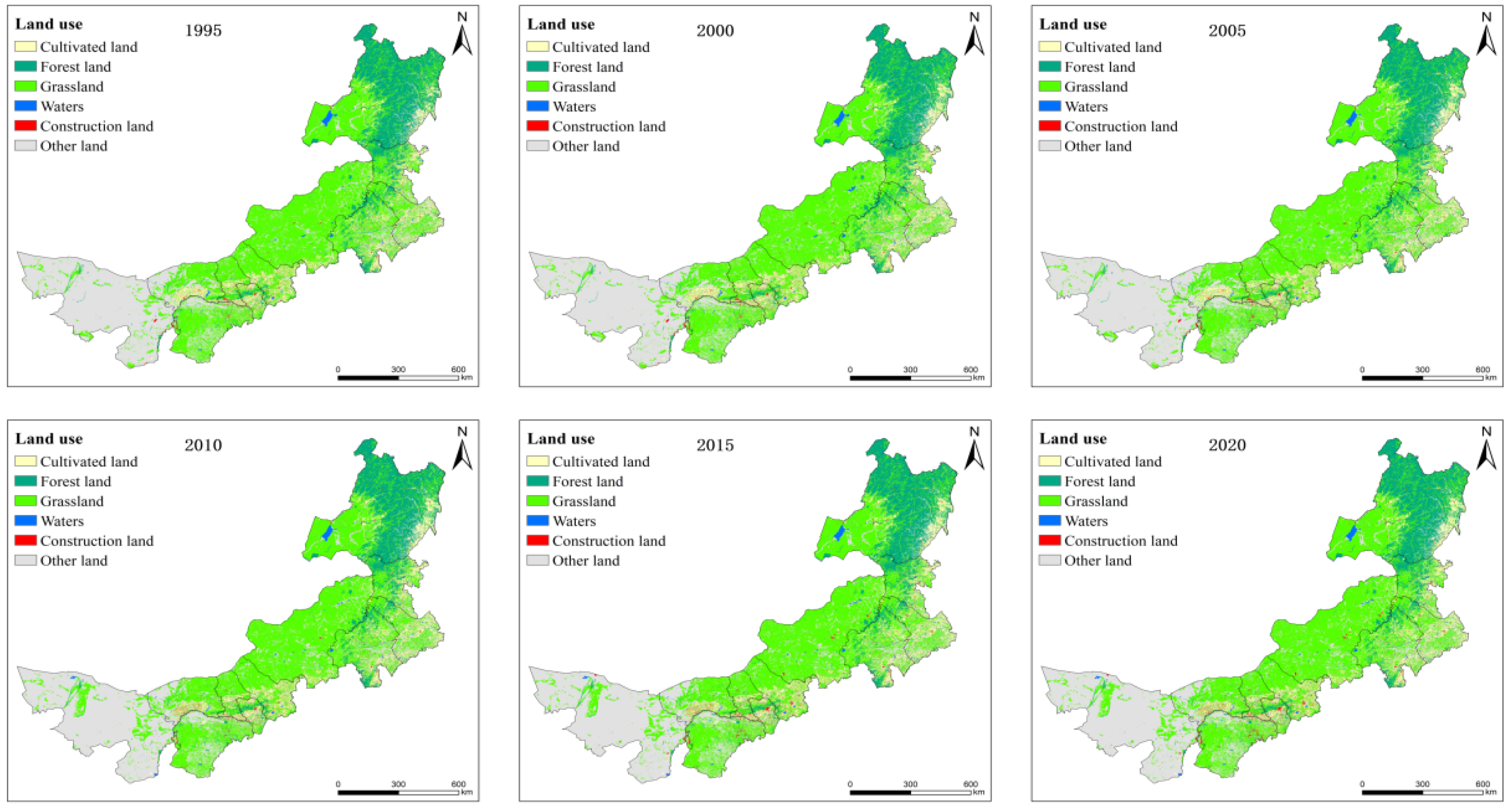
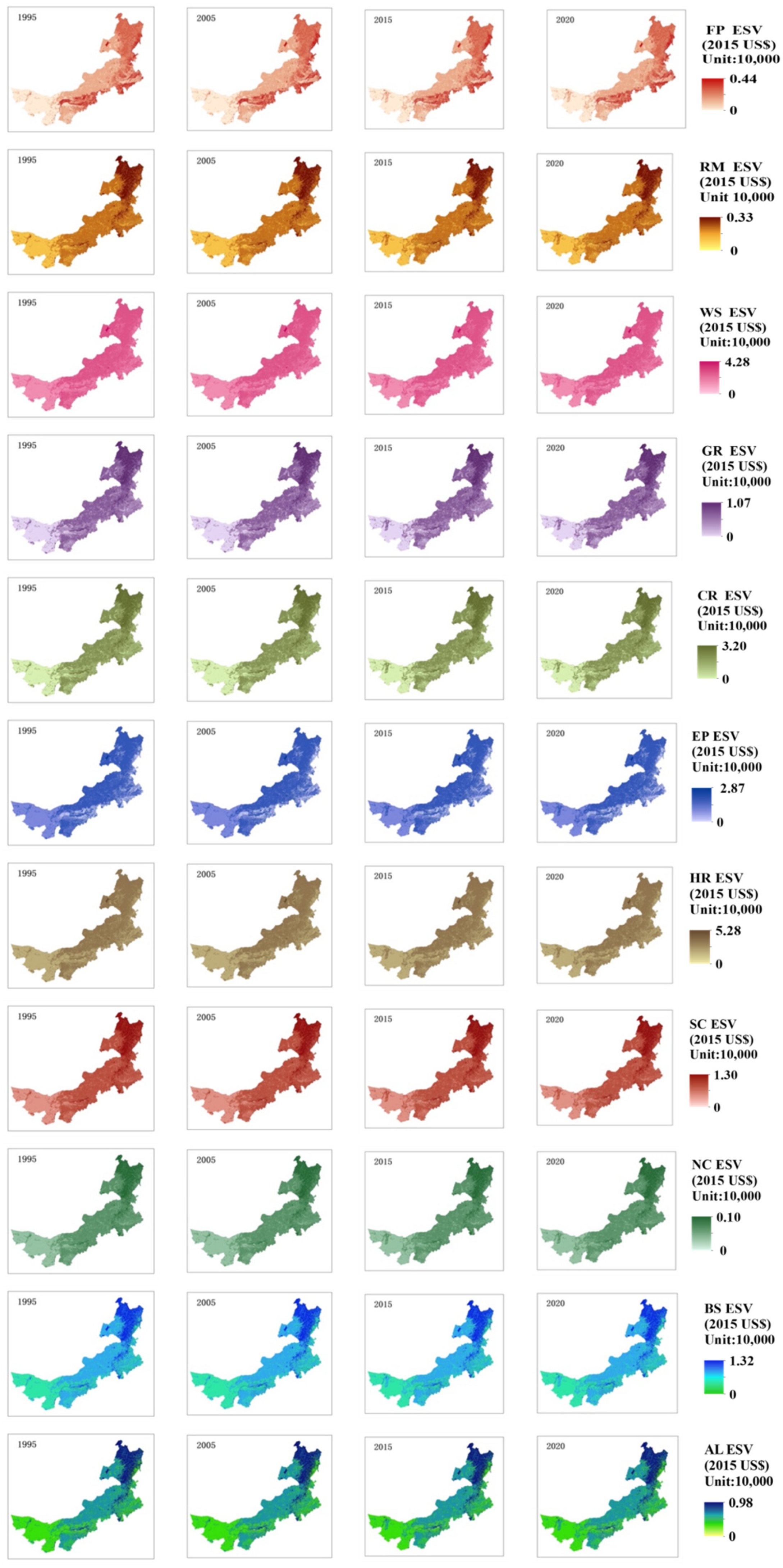
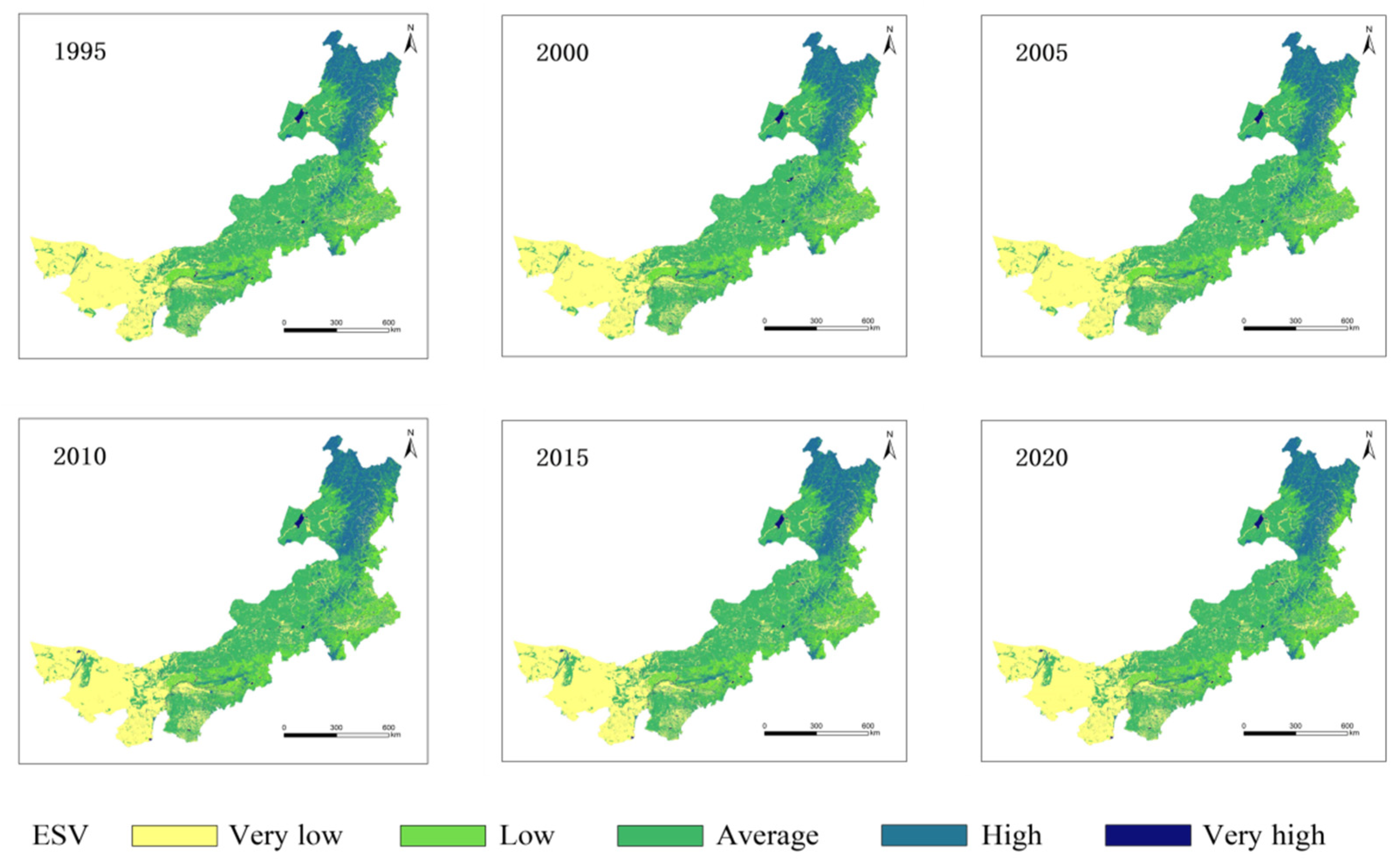
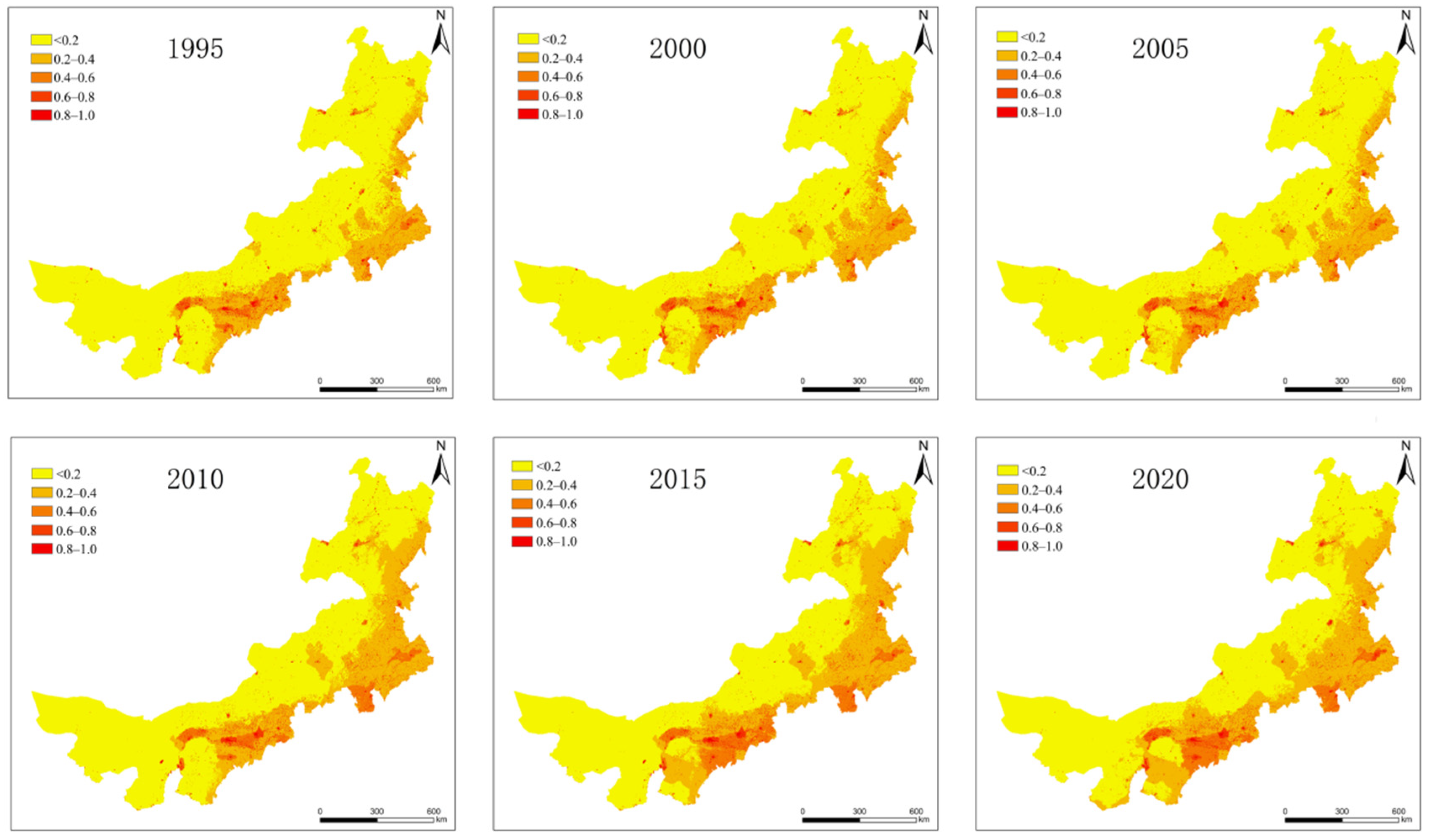
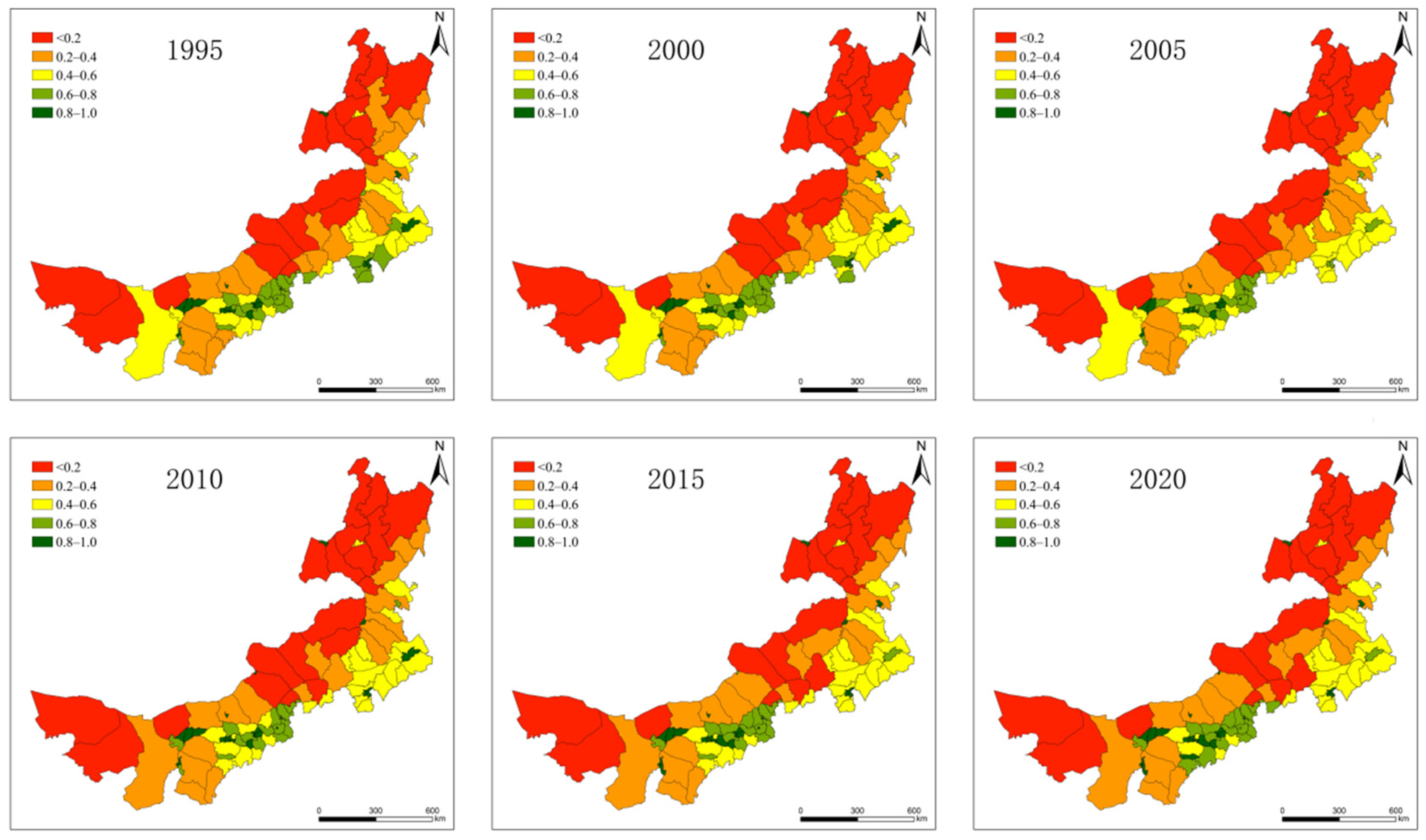
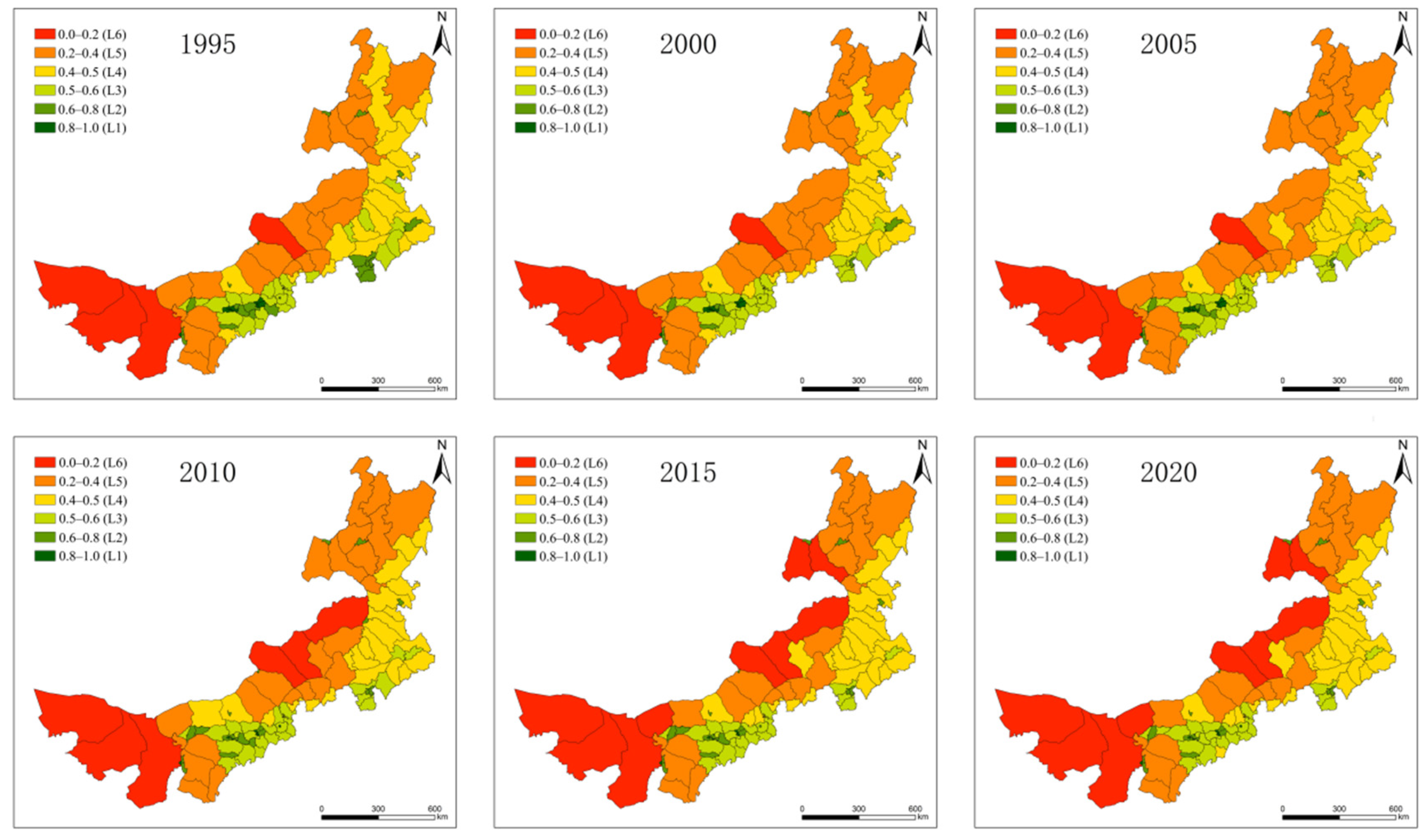
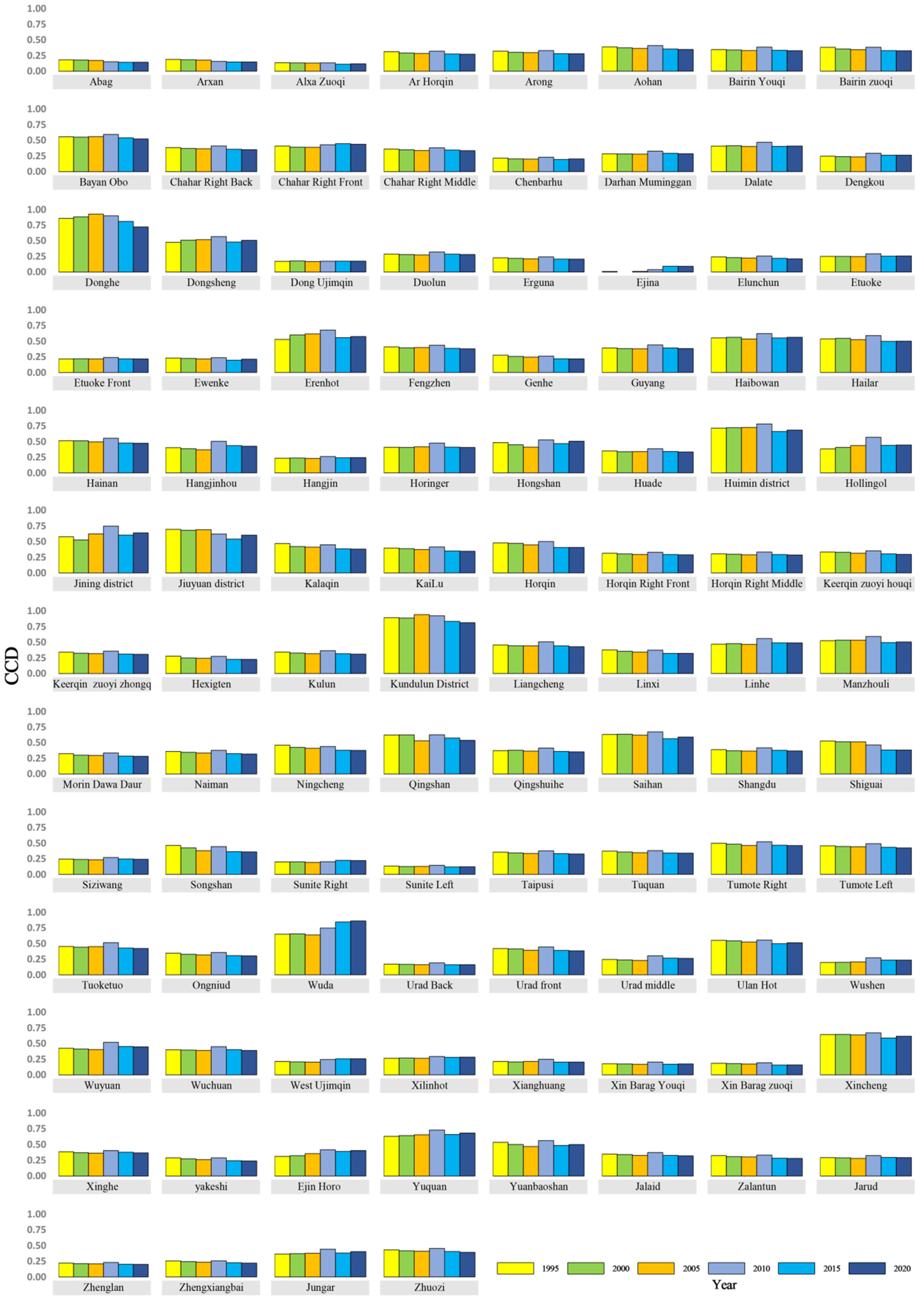
| Ecosystem Services Functions | Cultivated Land | Forestland | Grassland | Waters | Other Land | |
|---|---|---|---|---|---|---|
| Supply services | Food production | 263.5 | 83.7 | 71.3 | 248.0 | 3.1 |
| Raw material production | 124.0 | 195.3 | 105.4 | 71.3 | 9.3 | |
| Water supply | 6.2 | 102.3 | 58.9 | 2569.9 | 6.2 | |
| Regulation services | Gas regulation | 207.7 | 641.7 | 375.1 | 238.7 | 34.1 |
| Climate regulation | 111.6 | 1922.0 | 988.9 | 709.9 | 31.0 | |
| Environmental purification | 31.0 | 558.0 | 325.5 | 1720.5 | 96.1 | |
| Hydrological regulation | 83.7 | 1196.6 | 725.4 | 31,694.4 | 65.1 | |
| Support services | Soil conservation | 319.3 | 781.2 | 455.7 | 288.3 | 40.3 |
| Nutrient cycling | 37.2 | 58.9 | 34.1 | 21.7 | 3.1 | |
| Biodiversity | 40.3 | 713.0 | 415.4 | 790.5 | 37.2 | |
| Cultural services | Aesthetic landscape | 18.6 | 310.0 | 182.9 | 585.9 | 15.5 |
| Range of D Value | Level of CCD | Type of CCD |
|---|---|---|
| 0.8 < D ≤ 1 | Quality coordination (L1) | WUD > WES Quality coordination with lagging ecosystem |
| WUD ≈ WES Quality coordination of urbanization and ecosystem | ||
| WUD < WES Quality coordination with lagging urbanization | ||
| 0.6 < D ≤ 0.8 | Intermediate coordination (L2) | WUD > WES Intermediate coordination with lagging ecosystem |
| WUD ≈ WES Intermediate coordination of urbanization and ecosystem | ||
| WUD < WES Intermediate coordination with lagging urbanization | ||
| 0.5 < D ≤ 0.6 | Primary coordination (L3) | WUD > WES Primary coordination with lagging ecosystem |
| WUD ≈ WES Primary coordination of urbanization and ecosystem | ||
| WUD < WES Primary coordination with lagging urbanization | ||
| 0.4 < D ≤ 0.5 | Basic incoordination (L4) | WUD > WES Basic incoordination with hindered ecosystem |
| WUD ≈ WES Basic incoordination of urbanization and ecosystem | ||
| WUD < WES Basic incoordination with hindered urbanization | ||
| 0.2 < D ≤ 0.4 | Intermediate incoordination (L5) | WUD > WES Intermediate incoordination with hindered ecosystem |
| WUD ≈ WES Intermediate incoordination of urbanization and ecosystem | ||
| WUD < WES Intermediate incoordination with hindered urbanization | ||
| 0 < D ≤ 0.2 | Extreme incoordination (L6) | WUD > WES Extreme incoordination with hindered ecosystem |
| WUD ≈ WES Extreme incoordination of urbanization and ecosystem | ||
| WUD < WES Extreme incoordination with hindered urbanization |
| Ecosystem Services Functions | ESV | |||||
|---|---|---|---|---|---|---|
| 1995 | 2000 | 2005 | 2010 | 2015 | 2020 | |
| Food production | 84.41 | 85.64 | 85.45 | 85.92 | 85.93 | 85.89 |
| Raw material production | 105.37 | 105.21 | 105.00 | 105.87 | 105.83 | 105.77 |
| Water supply | 86.29 | 87.26 | 84.81 | 86.49 | 87.47 | 87.78 |
| Gas regulation | 340.87 | 339.01 | 338.03 | 341.41 | 341.30 | 341.13 |
| Climate regulation | 872.14 | 864.00 | 860.91 | 870.96 | 870.99 | 870.63 |
| Environmental purification | 322.08 | 320.39 | 318.23 | 321.42 | 321.78 | 321.83 |
| Hydrological regulation | 1049.90 | 1062.09 | 1031.89 | 1052.72 | 1064.77 | 1068.61 |
| Soil conservation | 421.26 | 419.41 | 418.28 | 422.29 | 422.16 | 421.94 |
| Nutrient cycling | 33.07 | 33.01 | 32.94 | 33.22 | 33.21 | 33.189 |
| Biodiversity | 364.43 | 361.50 | 359.76 | 363.99 | 364.12 | 364.03 |
| Aesthetic landscape | 162.90 | 161.77 | 160.79 | 162.76 | 162.91 | 162.90 |
| Total | 3842.73 | 3839.30 | 3796.11 | 3847.07 | 3860.47 | 3863.71 |
Publisher’s Note: MDPI stays neutral with regard to jurisdictional claims in published maps and institutional affiliations. |
© 2022 by the authors. Licensee MDPI, Basel, Switzerland. This article is an open access article distributed under the terms and conditions of the Creative Commons Attribution (CC BY) license (https://creativecommons.org/licenses/by/4.0/).
Share and Cite
Na, L.; Zhao, Y.; Guo, L. Coupling Coordination Analysis of Ecosystem Services and Urbanization in Inner Mongolia, China. Land 2022, 11, 1870. https://doi.org/10.3390/land11101870
Na L, Zhao Y, Guo L. Coupling Coordination Analysis of Ecosystem Services and Urbanization in Inner Mongolia, China. Land. 2022; 11(10):1870. https://doi.org/10.3390/land11101870
Chicago/Turabian StyleNa, Li, Yangling Zhao, and Luo Guo. 2022. "Coupling Coordination Analysis of Ecosystem Services and Urbanization in Inner Mongolia, China" Land 11, no. 10: 1870. https://doi.org/10.3390/land11101870
APA StyleNa, L., Zhao, Y., & Guo, L. (2022). Coupling Coordination Analysis of Ecosystem Services and Urbanization in Inner Mongolia, China. Land, 11(10), 1870. https://doi.org/10.3390/land11101870





